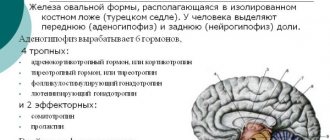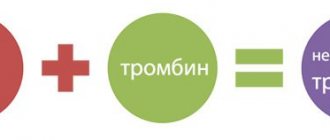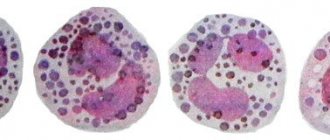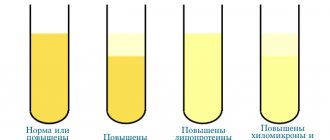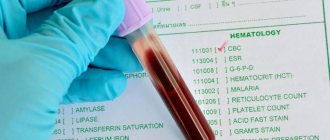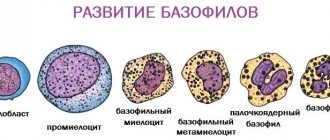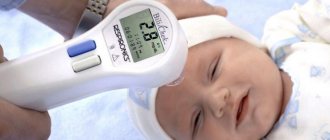Hypernatremia is a high concentration of sodium in the blood. But before we talk about what this means, why it is dangerous, and what it can lead to, we should remember the role of sodium in the human body.
Sometimes a doctor prescribes a patient a test for blood electrolytes: potassium, sodium, magnesium, calcium. Most often these are patients with neuromuscular disorders (myasthenia gravis), patients with diabetes mellitus, and chronic renal failure, when there is a risk of impaired electrolyte metabolism. In some cases, a blood plasma sodium test is ordered, and sometimes this sodium is elevated.
Why do we need sodium?
We are all very familiar with sodium, since everyone has sodium chloride, or table salt, in a salt shaker at home. There is quite a lot of sodium in nature: in every ton of the earth's crust there is about 25 kg of it, if distributed equally. There is also a lot of sodium in sea water in the form of various compounds, about 10 grams in each liter.
Sodium is found in all living organisms. Interestingly, there is more potassium inside living cells in the human body, but sodium is found mainly in the intercellular fluid, that is, outside the cells. This ratio indicates that the cell is alive. If the cell dies, then the ratio of potassium and sodium inside and outside it is the same. Such a difference in concentration cannot be obtained by chance; it is created by a special pump. It's called the sodium-potassium pump. More precisely, these are millions of processes of moving sodium ions outward. This process requires energy.
As a result, a difference in gradients is created, and since sodium and potassium have similar, but still different electrochemical potentials, as a result the cell acquires one electrical charge, and the intercellular space another. This allows many mechanisms of transmembrane transport, the transfer of many substances, and, in general, to ensure the life of the cell, to begin to work. In addition, sodium maintains acid-base and water balance and activates many enzymes. Without sodium, life is impossible. When is sodium in the blood elevated? What does it mean?
How to reduce your salt and sodium intake
Sodium is one of the vital minerals for humans, since it is present in all fluids and tissues in the body. Sodium regulates fluid balance and is part of lymph, blood and digestive juices. The main source of sodium in the human body is table salt. Moreover, one incomplete teaspoon is enough to compensate for almost the entire daily need for sodium.
A study by American scientists found that everyone, including children, should reduce their sodium intake to 2,300 mg per day or less (about 1 teaspoon of salt). Adults over age 50, people with high blood pressure, diabetes, and chronic kidney disease should reduce their sodium intake to 1,500 mg per day.
Excess sodium can cause edema as the body accumulates water. Manifestations of hyperactivity and irritability, increased blood pressure, and convulsions are possible. The body's desire to dissolve excess sodium is characterized by a constant feeling of thirst.
Here are some tips to help you watch your salt intake and reduce the amount of sodium you eat every day.
1. Give preference to fresh foods. As the study showed, we consume most of the salt together with processed foods and semi-finished products. If you buy ready-made food, semi-finished products and canned food, try to eat them in small portions and not often. Especially foods like pizza, sausages, bacon, sausages, hot dogs and hamburgers. Fresh produce tends to be very low in sodium.
2. Cook at home. This way you can control how much salt the food you prepare will contain.
3. Eat fruits and vegetables. Include plenty of vegetables and fruits (fresh or frozen) in your diet each day—they naturally contain low amounts of sodium. Eat a vegetable or fruit with every meal.
4. Choose dairy products and foods rich in protein. These products are low in sodium. Choose skim milk and yogurt instead of cheese, which has a lot of added salt. Buy fresh beef, pork, poultry, and seafood rather than processed meats because they contain added salt. Choose unsalted nuts and seeds.
5. Clean up your taste. Gradually add less and less salt to your food. Pay attention to the natural variety of flavors in food. Your need for salty foods will decrease over time.
6. Don't add salt. Do not add salt while cooking. Remove the salt shaker from the dining table, and generally hide the salt away in the closet. To improve the flavor of your food, use spices, herbs, garlic, vinegar, lemon juice or any other non-salty seasoning mixture. Try black and red pepper, basil, curry, ginger or rosemary.
7. Read labels. In the store, read the ingredients listed on the product labels. Choose foods that are labeled "low sodium" or "no added salt."
8. Ask not to add salt to your food. Of course, this is not possible everywhere, but in some restaurants or cafes, at your request, they may not salt the food you order. And the sauce can be served separately so that you can dress the salad yourself.
9. Pay attention to seasonings. Soy sauce, ketchup, marinades, olives, salad dressings and packaged condiments contain high amounts of salt. Buy low-sodium soy sauce and ketchup. Use other ingredients instead of canned olives.
10. Increase your potassium intake. Choose foods rich in potassium, which will help lower blood pressure. Sources of potassium are plant foods: vegetables, fruits, beans and cereals. There is a lot of potassium in potatoes - 0.5 kg of vegetables contains a daily dose of this mineral. Oranges, tangerines, apples, bananas, figs, grapes, lingonberries, strawberries, black and red currants, watermelons, melons, cherry plums, rose hips, raisins, prunes, dried apricots and apricots are richest in potassium.
What is hypernatremia?
When answering the question of what hypernatremia is, you can answer it scientifically, or you can answer it simply. In scientific terms: this is when the sodium content in the blood plasma exceeds 148 millimoles per liter (mmol/L). If this condition persists in the patient for more than 2 days, then this is not acute, but chronic hypernatremia. It's simple, but not entirely clear.
Here's a simple definition. High sodium in the blood is simply a lack of water in the body. It is known that the more salt you eat, the more you want to drink. Therefore, if less water comes in than it is consumed, a person becomes thirsty. This is the state of hypernatremia, high sodium in the blood, and we are all very familiar with it, especially after eating salty foods. But this is transient hypernatremia of a healthy person; it is quickly compensated by all mechanisms of water-salt metabolism. What are the causes of high sodium in the blood in other cases?
Hypernatremia increased sodium concentration
When the sodium content in the blood serum is elevated, a disease called hypernatremia occurs. With the development of this pathology, the concentration of sodium in the serum increases to more than 145 mmol/l - this is a moderate form of pathology. If the level of sodium in the blood exceeds 155 mmol/l, this indicates the development of a severe form of this pathology.
To clarify the amount of sodium ions in the blood serum, it is necessary to take an analysis. In modern laboratories using the latest technologies, it is possible to obtain informative results in the shortest possible time. But to do this, you must adhere to the rules of preparation for laboratory research. The specialist will recommend the day before:
- Do not overuse salty foods
- Reduce the amount of liquids
- Do not play sports and limit physical labor
- The last meal should be no later than eight hours before the test
- Donate blood in the morning on an empty stomach
The main reason for the development of this pathology is excessive salt consumption with insufficient fluid intake. These two factors lead to a rapid increase in sodium levels in the blood.
Hypernatremia also develops as a result of:
- Serious kidney pathology
- Violation of water balance and electrolyte metabolism in the body
- Dyspeptic disorders of the stomach and intestines
- Increased sweating
- Long-term use of drug therapy (hormones, steroids)
The symptoms of this disease are characterized by signs of hypertension, hyperthermia, drinking large quantities of liquids, rapid heartbeat, dry skin, trembling fingers, increased daily urine output, muscle tension, and loss of consciousness. If you do not treat on time, serious complications will arise from the heart, kidneys, nervous and circulatory systems, including death.
If the level of the element in the blood is elevated, specialists direct their actions to eliminate the cause of the pathology and recommend that the patient pay attention to nutrition. The diet should contain a minimum of salt and salty foods
It is advisable to eat food prepared at home. The menu includes dairy and protein dishes, fresh vegetables and fruits.
While watching the video you will learn about blood levels.
A complete examination of blood composition, especially with the help of automated titration, will accurately determine the level of sodium in the blood. A correct and nutritious diet, as well as regular preventive examinations with doctors, will allow you to promptly identify the slightest deviations from the norm of sodium in the blood.
Why does plasma sodium increase?
The most common cause of high sodium is excess water loss or insufficient water intake. In this case, the concentration of sodium in the body increases. Another mechanism is excess sodium intake, again table salt. Of course, the easiest way to get a lot of sodium in the blood is by eating sauerkraut or salted herring, but we are talking about diseases here. Therefore, hypernatremia can have the following causes:
- The patient loses water with increased metabolism: this is hyperthyroidism, when the patient has a constantly slightly elevated temperature;
- Fever and excessive sweating;
- An increase in sodium in the blood occurs with profuse diarrhea and vomiting in acute poisoning and intestinal infections (and with vomiting, chlorine is also lost).
The renal mechanism of fluid loss is very important. There is a disease called diabetes insipidus, the main syndrome of which is extremely strong thirst and the release of large amounts of low-density (hypotonic) urine.
Another reason for increased sodium in the blood is the so-called osmotic diuresis.
As for fluid deficiency, everything is clear here. This is dehydration in people in hot climates, these are patients who cannot ask for water due to unconsciousness, mental disorders or infancy. In rare cases, the cause of increased blood sodium is atrophy of the sense of thirst, which is associated with disorders in the central nervous system and may be a sign of a brain tumor.
Rare causes of hypernatremia include disruption of the activity of the osmotic center, which maintains control of the concentration of ions in the blood plasma, and is located in the structures of the central nervous system.
We will not go into details, we will only say that with hypernatremia, there is first an attempt to compensate for this condition by dehydrating the cells. We said above that sodium is in the extracellular space, and when there is too much of it, water from the cells goes there. Therefore, when sodium in the blood is elevated, what does it mean? And what happens is not just an abstract dehydration of the body, but a disruption of the functioning of almost every cell. How does the phenomenon of hypernatremia manifest itself?
Norm
Since basic electrolytes enter the body exclusively with food, their level depends on the correctness and balance of nutrition, on the performance of the kidneys and sweat glands. In addition, natriuretic proteins affect the sodium level, which contribute to the rapid removal of sodium from the body. In turn, the hormone aldosterone maintains sodium concentration at a constant level, but at the same time increases potassium loss.
The norm of sodium in the blood of men, women and children is the same, mmol/l.
But for children, the lower limit is slightly different from adults and mmol/l is considered an acceptable value.
The level of sodium in the blood of women during pregnancy may change. For example, in the second half of pregnancy, Na = mmol/l is considered normal. In various forms of late toxicosis, the concentration of the element can reach mmol/l.
Determining the norm of electrolytes in the blood is important for assessing the patient’s health, because the absence or insufficient quantity of certain elements leads to disruption of the functioning of almost all organs and systems.
How does hypernatremia manifest?
Of course, a person who is conscious will develop thirst. If there is pronounced hypernatremia, but there is no thirst, then the problem is in the feeling of thirst, in the mechanism itself, which is disturbed. If a person cannot pour water for himself, or does not know how to complain about thirst, this is one situation, but if thirst is not felt, this is already a deep pathology.
As all cells become dehydrated, including brain cells, they begin to shrink. And this leads to various disorders of the central nervous system. The symptoms of acute and severe hypernatremia are as follows: first, the coefficient of muscle excitability increases, increased convulsive readiness appears, tendon reflexes come to life, and then the person falls into a coma. If a person died from excessive saltiness of the blood, then most often, during an autopsy, subarachnoid or subcortical hemorrhages and numerous venous thromboses occur in the brain matter.
But the chronic form of hypernatremia is more common. Then the body tries to compensate for the loss of fluid from the cells into the intercellular space, and still finds reserves of osmotically active substances that compensate for the excess sodium. This helps relieve acute cellular dehydration, and therefore, with chronic high sodium levels in the blood, the symptoms are less severe.
So, patients who have impaired kidney function try to get rid of excess sodium, but they do not succeed very well. Therefore, they have a lot of urine, but the concentration, and, accordingly, its density is low. Therefore, they excrete large amounts of hypotonic urine. As a result, thirst is reactivated due to large loss of fluid. The result is a vicious circle, and this clinical picture is extremely indicative of the example of a disease such as diabetes insipidus. It is also called diabetes insipidus. Some interesting facts about this disease.
Diet and hypertension
Excess sodium in food increases blood pressure, so limit your intake to control your blood pressure. Sodium is a mineral necessary for life, its main role is to maintain adequate water balance in the body.
Sodium also helps the passage of electrical impulses along nerve fibers, allowing muscles to work.
The daily value for sodium in the diet is about 500 mg, with most Americans consuming 4,000 mg. The kidneys, which regulate the amount of sodium in the body, can usually compensate for excess or deficiency in the diet. However, in the case of heart, lung, kidney or liver disease, the body is not able to regulate salt levels on its own.
In addition, a high sodium diet can cause high blood pressure. Unfortunately, it is impossible to accurately predict whether excess sodium is the cause of high blood pressure; to reach this conclusion, you need to limit your salt intake and evaluate whether this will lower your blood pressure.
What is diabetes insipidus?
It is not surprising that both diabetes mellitus and diabetes insipidus are treated by endocrinologists. With diabetes insipidus, the earliest sign is the excretion of a large amount of urine: from 3 to 6 liters daily, but this is at an early stage, and “still flowers”. The amount of urine increases, and daily diuresis reaches 20 liters or even more. Then, when the body is exhausted by such an incredible regime (hence the second name - diabetes insipidus), the patient loses weight, his skin dries, his stomach stretches and sinks, because the patient constantly drinks and consumes an absolutely incredible amount of liquid for a healthy person.
Accordingly, the bladder and the renal collecting system are stretched. Everything in the body is aimed at producing this incredible amount of urine, which can reach the volume of two buckets per day. At the same time, the patient cannot stop drinking. If he is limited in fluid intake, he immediately becomes dehydrated. Dry mucous membranes occur, tachycardia appears, blood pressure drops, agitation and blood thickening occur, despite the fact that a person pumps a huge amount of fluid through himself every day. Why does this disease occur? The cause will be a deficiency of the hormone vasopressin, otherwise called antidiuretic hormone, ADH. Its task is to concentrate urine.
Normally, a person knows how to concentrate his urine. This is a rather interesting figure that few people think about. Normal glomerular filtration rates in the kidneys are 120 ml per minute. How much primary urine would we excrete per day if we did not concentrate it at all? Very simple. You need to multiply 0.12 liters by the number of minutes in a day. Accordingly, a person excretes about 170 liters of primary urine per day, but almost all of it is absorbed back (reabsorbed) and concentrated. As a result, we excrete about one and a half liters per day, that is, the concentration capacity of the human kidneys is colossal. If we didn’t have such a concentration apparatus, then we would have to live in water in order to constantly drink these 170 liters, compensating for the loss of fluid. About the same thing happens with diabetes insipidus; it is one of the causes of high sodium levels in the blood.
It is these concentration processes that are regulated by vasopressin, or antidiuretic hormone. Deficiency of this hormone can occur due to various reasons. It is produced in the brain, but if a person has had a severe traumatic brain injury, encephalitis, a tumor of the hypothalamus or pituitary stalk, there are metastases to the brain, or any autoimmune diseases, then this serious condition may develop.
Of course, some part of the hormone is still usually produced, and not a single person is able to go to the toilet and excrete more than 150 liters per day, but, nevertheless, this condition is very, very serious. Diabetes insipidus is treated very successfully, as it may not sound surprising. The patient takes the drug desmopressin for life, which is nothing more than a synthetic analogue of the antidiuretic hormone.
Usually this medicine is dripped into the nose, and already half an hour after instillation it acts for quite a long time, from 8 to 16 hours. It is quite enough for an adult to drop an appropriate dose of desmopressin into the nose once or twice a day to normalize kidney function. If the diagnosis is made in a timely manner and treatment is started quickly, the prognosis is very favorable.
Main indicators that have age differences in women
TOTAL PROTEIN
| Woman's age | Standard values, g/l |
| up to 60 years old | 64 – 83 |
| 60-75 years | 74 – 77 |
| after 75 years | 70 – 77 |
In pregnant women, the indicator may decrease and is 62-66 g/l (“pregnancy norm”).
A detailed analysis - a proteinogram, includes total protein, its fractions (absolute number with % ratio) and albumin-globulin ratio (A/G). Depending on the size and charge of the molecules, 5 fractions are distinguished in the plasma. Each has its own function.
| Fraction | Standard values for women under 60 years old, g/l (%) | After 60 years, g/l | Pregnant women, g/l |
| Albumin | 38 – 50 (53-63) | 34-38 | 26-32 |
| Globulins (total amount) | 6 – 13 (37-47) | 3.1-3.5 | |
| Globulins by fraction: Alpha-1-globulin | 2-4 (3.8-6.5%) | ||
| Alpha-2 | 4-8 (6.2-10.5) | ||
| Beta | 5-11 (10-15) | ||
| Gamma | 6-13 (14.5-19.5) | ||
| Albumin/globulin ratio | 1.32-1.95 | 0.84-1.26 |
The table shows that in elderly and pregnant women, normal values may be lower than the general population; this is not a pathology. Often, only albumins are indicated in the analysis, since globulins are predominantly immune proteins (antibodies). The former are formed mostly in the liver, and the latter - by cells of the immune system. Changes that require medical consultation and further examination:
- 1. Changes in the level of total protein (albumin + globulins)
Increased (>90 g/l): protein-producing tumors, severe infections with purulent foci or sepsis, tissue destruction in some chronic and autoimmune diseases (for example, systemic lupus erythematosus, rheumatoid arthritis). With any severe dehydration, blood thickening and a relative increase in total protein occur. Repeated vomiting, diarrhea, and acute bleeding can lead to this condition.
Decreased (<60 g/l): nutritional reasons (vegetarianism, diets, fasting), liver cirrhosis, kidney disease with nephrotic syndrome (protein is lost in urine), malabsorption in enteropathies, protein loss in extensive burns.
- 2. Changes in the ratios of fractions with a normal value of total protein. This is called dysproteinemia. The reference point is the value of the albumin-globulin coefficient. If liver and kidney function are impaired, the concentration of albumin may decrease. An increase in the globulin fraction occurs during infections, allergies, autoimmune diseases, and oncology. The lower the A/G ratio, the more difficult the process.
- 3. The appearance of proteins that are absent normally (paraproteins) or present in low concentrations.
- - C-reactive protein (CRP) - appears during acute inflammatory processes or exacerbation of chronic ones.
- - Alphafetoprotein - high levels are observed in some tumors, pregnancy, cirrhosis.
- — Monoclonal paraprotein (Bence Jones protein) – formed in myeloma.
- - Rheumatoid factor - increases in autoimmune diseases, chronic infections, malignant neoplasms, parasitosis.
- - Myoglobin - an increase occurs when muscle tissue is damaged (this is muscle protein) due to injury, myocardial infarction, abdominal surgery, after seizures.
GLUCOSE
Its values in capillary (from a finger) and venous blood are somewhat different. Most people know that high blood glucose levels occur with diabetes. However, there are two borderline disorders (prediabetes) - impaired glucose tolerance and impaired fasting glucose. In addition, pregnant women may develop gestational diabetes. Find out what a glucose tolerance test (GTT) will help you do, measuring sugar on an empty stomach and after a carbohydrate load.
With impaired fasting glycemia, the sugar level is no longer normal, but does not yet reach the parameters of diabetes. With impaired glucose tolerance, 2 hours after a carbohydrate load, the sugar level does not return to normal values, but remains in the borderline range. Gestational diabetes mellitus is a complication of pregnancy; it goes away (or remains) after delivery.
Low sugar levels – hypoglycemia, may occur:
- - When you skip a regular meal. Severe hunger, tremor of the hands, agitation are a clear sign of low blood glucose.
- - During intense physical activity, especially if it is not planned.
- - After taking alcohol or drugs.
- - For people with diabetes (high dose of insulin).
TOTAL CHOLESTEROL AND OTHER LIPIDS
The English abbreviation chol in a biochemical blood test means total cholesterol. A detailed analysis - a lipid profile, in addition to it includes low and high density lipoproteins (LDL, HDL), triglycerides. Everything together reflects fat metabolism in the body and allows us to assess the risk of developing atherosclerosis, as well as the dynamics during treatment.
Attention! Men over 35 and women over 40 should have their lipid profile checked annually. This prevents the development of atherosclerosis and cardiovascular diseases.
The table below shows the age dynamics of cholesterol levels in women.
| Age | Total cholesterol | LDL cholesterol | HDL cholesterol |
| 15-20 years | 2.91 – 5.10 mmol/l | 1.61 – 3.37 mmol/l | 0.78 – 1.63 mmol/l |
| 20-25 years | 3.16 – 5.59 mmol/l | 1.71 – 3.81 mmol/l | 0.78 – 1.63 mmol/l |
| 25-30 years | 3.44 – 6.32 mmol/l | 1.81 – 4.27 mmol/l | 0.80 – 1.63 mmol/l |
| 30-35 years | 3.57 – 6.58 mmol/l | 2.02 – 4.79 mmol/l | 0.72 – 1.63 mmol/l |
| 35-40 years | 3.63 – 6.99 mmol/l | 1.94 – 4.45 mmol/l | 0.88 – 2.12 mmol/l |
| 40-45 years | 3.91 – 6.94 mmol/l | 2.25 – 4.82 mmol/l | 0.70 – 1.73 mmol/l |
| 45-50 years | 4.09 – 7.15 mmol/l | 2.51 – 5.23 mmol/l | 0.78 – 1.66 mmol/l |
| 50-55 years | 4.09 – 7.17 mmol/l | 2.31 – 5.10 mmol/l | 0.72 – 1.63 mmol/l |
| 55-60 years | 4.04 – 7.15 mmol/l | 2.28 – 5.26 mmol/l | 0.72 – 1.84 mmol/l |
| 60-65 years | 4.12 – 7.15 mmol/l | 2.15 – 5.44 mmol/l | 0.78 – 1.91 mmol/l |
| 65-70 years | 4.09 – 7.10 mmol/l | 2.49 – 5.34 mmol/l | 0.78 – 1.94 mmol/l |
As you can see, with age, total cholesterol levels begin to rise. The higher it is, the greater the risks. Cardiologists adhere to a safe norm, regardless of age – up to 5.2 mmol/l. The range of values 5.2-6.2 mmol/l requires correction of nutrition and lifestyle. With values greater than 6.2 mmol/l, the risk becomes high, which requires medication. The doctor may prescribe cholesterol medications earlier if there are other aggravating factors (coronary heart disease, hypertension, diabetes, stroke, heart attack).
All indicators of the lipid spectrum can be divided into “bad” and “good” cholesterol. The latter includes only HDL. The higher the high-density lipoprotein level, the better. They transport fats to the liver, where they are processed. High levels of HDL indicate a favorable course of lipid metabolism, and a decrease increases the risk of developing (or progression) atherosclerosis.
In pregnant women, total cholesterol levels are allowed to increase by 1.5-2 times. This is necessary for normal growth and development of the fetus. Imagine that in the third trimester its level can rise to 13 mmol/l and even a little higher. The alarm should be sounded when total cholesterol in a pregnant woman increases by more than 2.5 times the norm.
NITROGEN WASTE (UREA, CREATININE, URIC ACID)
These are products formed as a result of the exchange of proteins and nucleic acids. Normally, they are excreted by the kidneys, and their concentration is maintained constant in the blood plasma.
| Woman's age | Creatinine, µmol/l | Urea, mmol/l | Urinary acid, µmol/l |
| 18-20 years old | 51 – 81 | 2.5-6.4 | 150-350 |
| 20-60 years | 53 – 97 | ||
| after 60 years | 53 – 106 | 2.9-7.5 | 210-430 |
From a diagnostic point of view, an increase in the concentration of urea and creatinine primarily indicates kidney pathology. Increased uric acid levels are more common with gout. Let's look at the reasons in more detail.
- 1. Creatinine (designated as crea) is a breakdown product of the muscle tissue substance creatine. The only clinical significance is its increase in blood plasma, which can occur:
- — In case of impaired filtration and excretory function of the kidneys. This is a marker of renal failure, which is caused by a number of kidney diseases (glomerulonephritis, nephropathy due to diabetes mellitus or hypertension, pyelonephritis, urolithiasis).
- — For long-term compression syndrome, burns with a large area of damage.
- — With pathology of the thyroid gland, accompanied by hyperthyroidism.
- 2. Urea (urea in a biochemical blood test) is also a product of protein metabolism; its increase, as in the case of creatinine, is observed in renal failure and long-term compartment syndrome. It also increases with enriched protein nutrition, with inflammatory processes in tissues with decay, sepsis, and dehydration. The decrease occurs with a diet low in protein, exhaustion, increased diuresis after taking diuretics, and liver failure. In the latter case, this is an unfavorable sign, since the ability of the liver to form urea decreases. This leads to an increase in the concentration of ammonia and its toxic effect on the brain (hepatic encephalopathy develops).
- 3. Uric acid (uricacid in a biochemical blood test) is a product of the metabolism of purine bases, 70% of it is excreted by the kidneys, the rest through the intestines.
An increase is observed with renal failure, increased cell death (for example, against the background of antitumor therapy), alcoholism, obesity, and a tendency to increased cell production. The danger is that constantly high levels of uric acid lead to the deposition of its salts in joints, soft tissues, kidneys and the development of gout.
During pregnancy, there is a decrease in the level of nitrogenous wastes, which is associated with an increased rate of renal blood flow and the filtration capacity of the kidneys.
Attention! The myth of "slag". Alternative medicine believes that harmful substances from food and the environment accumulate in the body, making it “slagged.” A cleanse or detox is suggested for this. Options include fasting, enemas, diuretics, laxatives and other “cleansing procedures”, which can ultimately lead to malfunction and diseases of internal organs. The body is not designed to accumulate harmful substances, and its excretory systems cope quite well with metabolic products. It seems that the problem is not “slag”, but “slagphobia” of this mythical threat.
BILIRUBIN
Total bilirubin (tbil in a biochemical blood test) consists of its direct and indirect fractions. This is a red-brown pigment that is found in the blood (formed from hemoglobin in red blood cells), processed by the liver and excreted in bile. In adult women, its normal values do not change throughout life, but are somewhat different from men (the female norm of red blood cells is slightly less).
| Bilirubin | Normal values, µmol/l |
| General | 8.2 – 17.1 |
| Direct (tied) | 0.9 – 4.2 |
| Indirect (free) | Until 17.2 |
The fraction that is formed from decomposed hemoglobin is called indirect. It is the most toxic because it is able to penetrate the blood-brain barrier into the brain and destroy cells. Indirect bilirubin in the liver is converted into direct bilirubin, which is non-toxic, which is released into the bile and then into the intestines. When total bilirubin increases to more than 50-60 µmol/l, the sclera, mucous membranes and skin become yellow.
Important information is provided by the faction at the expense of which his promotion occurred:
- 1. Increased indirect fraction - in case of anemia due to increased destruction of red blood cells (hemolytic). They can be hereditary and acquired (parasitic infections, autoimmune diseases, toxic). The cause may also be extensive internal bleeding, when a lot of heme, a substrate for the formation of free bilirubin, is released from destroyed red blood cells.
- 2. Both fractions are elevated – occurs with liver damage (acute hepatitis, decompensation of cirrhosis, the effect of hepatotoxic poisons). Another group of reasons is a violation of the outflow of bile, in which obstructive jaundice develops (stones, tumor formations).
ENZYMES
- 1. Liver transaminases – alanine aminotransferase and aspartate aminotransferase (ALT, AST).
These are intracellular enzymes of liver cells - hepatocytes. But they are also found to varying degrees in other organs (heart, skeletal muscles, kidneys, pancreas). ALT is more specific for the liver. Both enzymes carry out biochemical reactions of synthesis and breakdown of substances entering the cell.
| Woman's age | ALT, U/l | AST, U/l |
| 18-60 years | 7 – 31 | Less than 31 |
| 60-90 years | 10 – 28 | |
| after 90 years | 5 – 24 |
A 2-fold increase in level is diagnostically significant. The reason is cell damage (inflammation or death). An increase in ALT is specific to liver damage (acute, chronic hepatitis, taking hepatotoxic drugs), extensive injury to skeletal muscles. Less commonly – with myocardial infarction, heart disease. An increase in AST is less specific to the liver, and more specific to damage to the heart and skeletal muscles. The AST/ALT ratio (de Ritis coefficient, norm 1.33) helps to differentiate where the pathological process occurs. It increases in heart disease and decreases in liver pathology.
- 2. Alkaline phosphatase (ALP)
| Woman's age | ALP Units |
| From 20 to 24 years old | 85/td> |
| From 25 to 34 years old | 85 |
| From 35 to 44 years old | 95 |
| From 45 to 54 years old | 100 |
| From 55 to 64 years old | 110 |
| From 65 to 74 years old | 85 |
| Over 75 years old | 165 |
This is an enzyme that is found in many organs, but most of all in liver cells, bile ducts, and bone tissue. Pregnant women have a lot of it in the placenta. The reasons for the increase may be:
- — Damage to hepatocytes (assessed together with transaminases and bilirubin) in acute and chronic hepatitis, liver metastases;
- — Impaired transport of bile (obstruction of the bile ducts with stones or tumors, cholangitis);
- — Active metabolic processes in bone tissue (healing of fractures, bone tumors/metastases);
- — Pregnancy;
- — Intestinal diseases (bacterial infections, ulcerative colitis).
- 3. Gamma-glutamyltransferase (GGT)
This is an enzyme that is involved in the metabolism of amino acids and accumulates mainly in the kidneys, liver and pancreas. In women, its value does not depend on age, but differs from men.
| Normal GGT levels | |
| Floor | GGT level (units/l) |
| Men | Up to 49 |
| Women | Up to 32 |
| From 45 to 54 years old | 100 |
| From 55 to 64 years old | 110 |
| From 65 to 74 years old | 85 |
Reasons for the increase:
- — Diseases of the liver and bile ducts;
- — Alcohol abuse (specific symptom);
- — Pancreatitis, pancreatic tumors;
- — Taking paracetamol or phenobarbital (the drugs stimulate the formation of the enzyme);
- — Condition after kidney transplant;
- 4. Amylase
The richest in content are the pancreas (40%) and salivary glands (60%). Its increase in acute pancreatitis (not only blood counts, but also urine counts) is clinically significant. A decrease in its level in severe pancreatitis is a bad sign, which indicates the development of pancreatic necrosis.
| Age, years | Amylase, U/l | |
| Alpha | Pancreatic | |
| 16-18 | 25-125 | <39 |
| 18-70 | 25-125 | <39 |
| 70 and above | 20-160 | <53 |
* Alpha – total amount of enzyme
- 5. Creatine kinase (creatine phosphokinase, CK or CPK)
It is found in large quantities in muscles (cardiac, skeletal) and the brain. Its factions matter:
- — CPK-MB is located in the heart muscle and increases when it is damaged (heart attack, cardiac contusion, myocarditis);
- — CPK-BB – brain enzyme;
- — CPK-MM is located in skeletal muscles.
Typically, the level of total CPK is examined; if a heart attack is suspected, a rapid determination of CPK-MB is performed in combination with other markers. In women, there are no significant age-related fluctuations in reference values. A slight increase is possible in old age (after 90 years) and during pregnancy.
How to diagnose hypernatremia?
The most important, simple and accurate way to do this is to take a blood test for sodium. If it is more than 148 mmol per liter, then this is definitely hypernatremia. Clinical diagnosis "blind" is extremely difficult and can be erroneous. Of course, symptoms such as seizures can be a sign of hypernatremia, but they can also be a symptom of several dozen other conditions. And if the patient is unconscious, then it is impossible to find out from him the characteristics of his eating behavior, whether he was thirsty, how much salty food he consumed, whether he has a history of diabetes insipidus, and so on. Therefore, it is worth focusing only on laboratory indicators. How is hypernatremia treated?
Low blood sodium levels (hyponatremia):
- lack of sodium in food
- loss of fluid through the skin with severe sweating, through the lungs with prolonged shortness of breath, through the gastrointestinal tract with vomiting and diarrhea, with fever (typhoid, typhus, etc.)
- overdose of diuretics
- adrenal insufficiency
- hypothyroidism
- diabetes
- swelling
- renal failure, nephrotic syndrome
- chronic heart failure
- Liver cirrhosis, liver failure.
Loss of sodium, hyponatremia, may also be associated with taking certain medications (anti-inflammatory, diuretics).
Treatment of hypernatremia
The simplest and most natural way to correct mild hypernatremia is to simply drink clean water as much as required, but since patients are most often admitted to the hospital in a rather serious condition, treatment is carried out using infusions of solutions containing different concentrations of table salt.
If a person has a fluid deficiency, then he is injected with a regular isotonic solution (0.9% sodium chloride) until he has normal blood pressure, and then the concentration of sodium chloride in the solution is reduced by half, and no longer is administered. 0.9%, and 0.45%, additional glucose is introduced. This allows you not only to compensate for the lack of isotonic fluid, but also to slightly eliminate sodium.
If necessary, diuretics are prescribed in addition to the treatment of hypernatremia, then the intermediate result is assessed, and if everything is in order, then the treatment can be considered complete. However, it is necessary to do all the described measures not in half an hour, but very slowly, since a rapid change in the concentration of electrolytes, even for the better, can cause too sudden changes in the body, especially if the patient is elderly. As a last resort, if infusion is not possible or the condition is quite severe, then you can resort to hemodialysis. This emergency artificial kidney procedure can successfully remove excess sodium.
Sadly, most patients with severe hypernatremia are in critical condition due to underlying diseases, advanced age and decompensation. Therefore, according to statistics, half, and even a little more, of patients with severe hypernatremia die. As a rule, these are not young people with excess salt, but people suffering from severe and chronic multiple organ, cardiovascular failure, and chronic renal failure.
Preparation for analysis and collection of material
Typically, blood is taken from the cubital vein to determine sodium levels. The procedure is carried out in the morning, on an empty stomach. Within half an hour, you need to stop smoking, not tax your body physically, and avoid emotional stress. 5-7 days before the study, you must stop taking medications that may affect the results of the study: diuretics, corticosteroids, hormonal drugs, tetracycline.
Blood sampling is performed with short clamping of the vein and without additional stress on the muscles of the shoulder and forearm. The material is placed in a test tube and can be stored in it for up to 3 hours at room temperature. In the laboratory, serum is isolated from the blood. The study of sodium levels can be carried out using flame photometric, turbidimetric, colorimetric or ion-selective methods. The latter is used most often. Ionometry using sodium-selective electrodes is a physicochemical method that is based on measuring the interelectrode potential formed upon contact with the test solution of the selective electrode and the reference electrode. Preparation of analysis results takes 1 business day.
Na and vasopressin
Changes in blood pressure and plasma osmolality are the two main signaling systems that regulate the secretion of the hormone vasopressin. As plasma water decreases, Na content and osmolality increase. These changes are sensed by sensory cells in the hypothalamus, and as a result, the production of vasopressin increases.
Under the influence of vasopressin, the reabsorption of water in the kidneys increases to restore the water balance of the blood. As a result, Na concentration returns to normal. Conversely, when plasma water increases, plasma sodium concentration, osmolality, and vasopressin production decrease and the collecting duct becomes impermeable to water. As a result, water output increases to restore sodium levels, which are currently low.
A decrease in blood pressure can also serve as a powerful stimulus for the production of vasopressin. This is facilitated by the hormone angiotensin and the entry points of impulses into neurons, even with a lack of osmolality.
The reduced blood pressure is detected by pressure receptors in the aorta and carotid arteries. It occurs acutely during hypovolemia (decreased circulating blood volume) or during disorders associated with decreased arterial perfusion (effective blood volume).
Examples of diseases in which these phenomena occur are cirrhosis and heart failure. Water metabolic disorders occur due to loss or increase in water supply . The causes are usually changes in the conditions of accumulation and regulation of water balance by the kidneys. Most often this occurs as a result of dysfunctional vasopressin production.
Interestingly, Na preparations are widely used in medicine. For example, sodium sulfate or sodium sulfate is a known laxative. Therefore, such a qualitative reaction to sodium sulfate as increased intestinal motility is used for constipation. However, this drug should not be prescribed for abnormal electrolyte values.
Source: 1diagnos.ru
Reasons for deviations
If the patient has low sodium, symptoms include weakness and thought disorders. If Na levels drop quickly, a person may suddenly feel weak, and in severe cases, loss of consciousness or coma may occur. If sodium falls slowly, there may be no symptoms at all. Therefore, this test should be performed when you suspect this problem, even if there are no symptoms.
If a patient has elevated Na in the blood, this is indicated by thirst, drying of the mucous membranes (for example, in the mouth, eyes), decreased urination, muscle twitching or convulsions, and overexcitation of the nervous system. When sodium levels rise, symptoms may include extreme agitation, unexplained behavior, coma, and convulsive episodes.
One of the most common causes of increased Na concentration in the blood is water imbalance. Of all the body fluids, humans have the most water. In people with a lean build, water makes up about 60% of their total body weight. Of this amount, 2/3 is intracellular fluid and 1/3 is intercellular. Since adipose tissue contains less water than muscle tissue, the amount of water in total body weight is less in women.
We must understand that water can move between these spaces in the body. Because of this, the content of Na and other electrolytes may vary. A necessary condition for the movement of water between the spaces of the body is the osmotic concentration, which can be expressed as osmolality. This is the name for measuring the concentration of electrolytes in the blood plasma, which is measured in osmoles per liter. Sodium is a major component of plasma osmolality, where water moves from areas of low osmolality to areas of higher osmolality.
The amount of water in plasma is regulated by interactions between sensory organs (eg, the carotid body and hypothalamus), antidiuretic hormone (vasopressin), and the kidneys. Although the gastrointestinal tract, skin and bronchi in the lungs can lose sodium and water as they function, the kidneys are the only organ capable of conserving and excreting sodium and water under very strict control.
Clinical symptoms of hyponatremia
In most cases, a decrease in sodium concentration in the blood does not cause any symptoms, and is often detected only during laboratory testing. This happens during medical examinations among athletes, among people doing heavy physical labor, or among adherents of a starvation diet. As a rule, in these situations it is temporary and can be eliminated by simply normalizing the diet and drinking regime.
In other cases, when hyponatremia is stable and caused by various diseases, it has characteristic symptoms, depending on the speed of development:
- with an acute lack of sodium, headaches, dizziness, general weakness, convulsions appear, coma and even death may develop;
- with the chronic, gradual development of sodium deficiency, a decrease in blood pressure, muscle and general weakness, dry and sagging skin, digestive disorders, poor sleep, nervousness are characteristic; there may be disturbances in reflexes, orientation and even mental disorders.
We also recommend studying this topic:
Reduced potassium ions in the blood: symptoms of hypokalemia
Electrolytes of our body
Before we talk about sodium, we need to understand what electrolytes are. These are electrically charged particles that help transport nutrients and metabolic wastes into and out of cells, maintaining vital water balance and helping to stabilize acid-base balance (pH). Therefore, deviations of sodium and other electrolytes from the norm have an extremely negative impact on health.
Electrolytic panel tests measure the level of major electrolytes in the blood. These include studies of sodium (Na+), potassium (K+), chlorine (Cl-) and bicarbonate (HCO3- or total CO2). These substances are essential for the functioning and normal functioning of the body and enter the body with food. The kidneys help maintain proper electrolyte levels through reabsorption and excretion in urine.
Electrolyte and acid-base imbalances may be present in a variety of acute and chronic diseases. Therefore, electrolyte testing is often used in emergency rooms and when hospitalized patients. The levels of electrolytes in the blood of women and men are usually the same, and the electrolyte panel itself examines:
- Sodium is the body's most abundant electrolyte, found both inside and outside cells. In adults, the norm of sodium in the blood is from 136 to 145 mmol/l.
- Potassium - resides mainly inside cells. A small but vital amount of potassium is also found in the blood plasma. Potassium levels are monitored in patients with heart disease to assess the ability of the heart to contract.
- Chlorine - this electrolyte is in constant motion, penetrating and leaving cells. It helps maintain electrical neutrality, and its levels usually reflect sodium levels.
- Bicarbonate – The main task of bicarbonate is to maintain a stable level of acid-base balance and electrical neutrality.
The overall balance of these substances indicates the state of health and well-being of body functions that are important for maintaining the functioning of the vital organs of the body. These include the work of the heart, muscle contraction and the conduction of nerve impulses.
It should also be taken into account that any disease that affects the amount of fluid in the body affects the lungs, kidneys, metabolism and breathing. This increases the risk of imbalance of fluids, electrolytes, and acid-base balance. The normal pH level must be maintained between 7.35 - 7.45, and electrolytes must be in balance for normal metabolism and supply of tissue cells with sufficient oxygen.
During electrolyte testing, the anion gap is measured. This indicator of the electrolytic panel indicates the difference between positively and negatively charged ions (cations and anions). An abnormal anion gap value is nonspecific and may suggest the presence of respiratory disorders or toxic substances.
